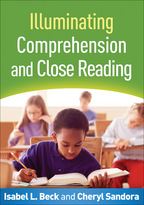Illuminating Comprehension and Close Reading
Isabel L. Beck and Cheryl A. Sandora
Includes Common Core Content
“If you think you already know all you need to about close reading, think again. Beck and Sandora have produced one of the most effective, comprehensive resources I've seen for professional development in reading comprehension. The format is user friendly, and the lessons are well described and engaging. This book should be on every teacher’s desk, and it is a 'must have' for students in teacher education programs and for reading specialists and professional development providers. Administrators, take note: this book demonstrates what you should be looking for when evaluating an excellent reading lesson.”
—Rachel L. McCormack, EdD, Professor of Literacy Education, School of Education, Roger Williams University
“This book is a home run! Educators looking to implement a comprehensive approach to planning deep and meaningful lessons will appreciate this powerful resource. Beck and Sandora demystify the comprehension and close reading puzzle and provide instructional routines, text-based examples, and practical commentary. Reading the book feels like you are engaging in clear and concrete professional development. A 'must have' for any teacher who wants to take text-based instruction to the next level and meet the rigorous demands of the CCSS.”
—Lisa M. Yonek, PhD, Elementary Literacy Supervisor, Pittsburgh, Pennsylvania, Public Schools
“Situated in generative theory and research, this book is above all practical. As promised, the book delivers on the 'why' and the 'how': it both makes a compelling case for close reading and provides comprehensive and wise assistance to teachers.”
—Jeffrey D. Wilhelm, PhD, Distinguished Professor of English Education, Boise State University
“Illuminating Comprehension and Close Reading has immediately earned a top spot in my professional library. Beck and Sandora offer a four-step approach to creating meaningful lessons for students with varying degrees of experience with close reading. They provide in-depth lesson examples for narrative and informational texts (with texts supplied for readers to photocopy or download), as well as guided practice opportunities for readers to create their own lessons. One of the most exciting features is the detailed explanation of how to develop queries that focus student attention on important text content, vocabulary and language use, elements of genre, and techniques of the writer.”
—Susan Watts Taffe, PhD, School of Education, University of Cincinnati
Table of Contents
I. The Hows and Whys of Comprehension and Close Reading1. Overview and Rationale
2. A Sprint through Theory and Research: From Questioning the Author to the Present
3. Queries and the Role They Play in Discussion
4. Just the Gist: Developing Instruction for Basic Comprehension
5. Close Reading: Gist to Grist
6. A Closer Look at Close Reading: Modeling the Development of Close Reading Activities
7. Your Turn for a Narrative
8. Your Turn for an Informational Article
9. Poetry: A Treasure Chest of Close Reading
10. Younger Students: Last but Far from Least
Frequently Asked Questions
II. Text Lessons for Comprehension and Close Reading
Lesson 1. Does an Elephant Never Forget?
Lesson 2. Li Ju and the Magic Tapestry
Lesson 3. Arachne, the Spinner
Lesson 4. Tribute to a Dog
Lesson 5. The Lady, or the Tiger?
Lesson 6. The Hound of the Baskervilles
Lesson 7. The Tell-Tale Heart
Lesson 8.John F. Kennedy's Inaugural Address
Appendix. Reproducible Texts from Part One
Common Core State Standards
About the Authors
Isabel L. Beck, PhD, is Professor Emerita of Education in the School of Education at the University of Pittsburgh. She has conducted research and published widely in the areas of decoding, vocabulary, and comprehension. Her contributions have been acknowledged by awards from the International Literacy Association, the Literacy Research Association, and the American Federation of Teachers. She is an elected member of the National Academy of Education. Her books include Bringing Words to Life, Second Edition.Cheryl Sandora, PhD, is a Research Associate at the Learning Research and Development Center and a Fellow at the Institute for Learning, both at the University of Pittsburgh. Her work has included classroom-based research on comprehension and vocabulary instruction, the development of instructional materials for English/Language Arts classrooms, and professional development for districts around the country. She has taught in public, urban, and rural school districts and has served on the faculties of several universities.
